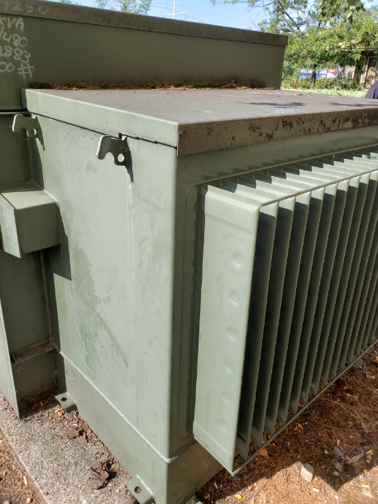It is becoming increasingly common to find electric transformers at large commercial, institutional and industrial facilities. Although the transformer is located on the facility’s property, it is sometimes unclear who actually owns the transformers and is responsible for the maintenance and spills. The transformer may be owned by the facility, typically seen on older properties or those that require multiple transformers with high voltage, or by the local power company.
Units that contain oil are called “wet” transformers as they contain various amounts of mineral-based oil typically referred to as transformer oil. It can also be common to find older wet transformers laced with polychlorinated biphenyls (PCBs). Although the use of PCBs in transformers has been phased out, the older transformers with PCBs can be problematic to clean up in the event of a spill. One of the biggest issues of not knowing who owns the transformers is determining the responsibility of cleaning up oil spills. Ultimately, for any transformer that contains oil, a plan should be in place for addressing a spill.

Dry vs Wet Transformer: Identifying Which Transformer Has Oil
For large commercial and industrial facilities, wet transformers are typically the type of electric unit used. Wet transformers are more efficient in cooling the coils in the systems, which leads to better overload capacity and a better life expectancy compared to dry transformers. So, how do you identify a wet transformer from a dry transformer? There are multiple ways to identify the difference between the two: facilities can either find a nameplate or manufacturer’s specification document that describes the system or, they can simply look at the structural components. In many cases, the transformer units lack the nameplates or documentation required to identify the model, so it is much easier and more convenient to evaluate the structure. When looking at a dry transformer, it will appear to be a square box with no attachments. With a wet transformer, there will be multiple attachments and it will have a main frame with another box welded to it. This additional welded piece is where the oil is stored. On bigger, higher voltage units, the additional attachment may have cooling fins instead of just being a box.
Who is Responsible for Oil-Filled Transformers?
It can be difficult to determine who owns the transformers if there is a lack of paperwork. For ownership determination, the facility should check property management documents, or the facility can call the local utility company. If the facility has an oil-filled transformer on the property, no matter who owns it, the facility has some level of responsibility. Remember, the goal is to prevent oil from reaching state waters and the facility would be the quickest to respond. If it is determined that the utility company owns the transformer, the facility is then granting permission to the utility company to place a transformer on their property. There is no regulation exemption for storing someone’s oil on the property. The owner or operator of a facility should coordinate with the utility company to determine who prevents and cleans up oil spills from the transformer. Although the responsibility will depend on state laws, the owner, or in this case, the utility company, is legally responsible for the transformer and preventing spills. The owner or operator of the facility needs to take into account that if a spill was to occur, the oil spilled could negatively impact the property and lead to further issues if the spilled material reaches navigable waters or leaches into the ground.
In situations where the amount of oil located at the facility is over the 1,320-gallon threshold, requiring an SPCC Plan can be tricky. According to the EPA’s SPCC Guidance for Regional Inspectors,
If a facility is regulated under the SPCC rule, it is the responsibility of the facility owner and operator to ensure that an SPCC Plan is prepared. A site may have multiple owners and/or operators, and therefore can have several facilities. Factors to consider in determining which owner or operator should prepare the Plan include who has control over day-to-day operations of the facility or particular containers and equipment, who trains the employee(s) involved in oil handling activities, who will conduct the required inspections and tests, and who will be responsible for responding to and cleaning up any discharge of oil. EPA expects that the owners and operators will cooperate to prepare one or more Plans, as appropriate.
The key takeaway is that the EPA acknowledges that there may be multiple owners and/or operators in a facility. With the case of transformers, granting permission to have a utility-owned transformer onsite is identifying both the facility and the utility company as owners/operators, therefore both are responsible for the transformer. It is important to note that even though the facility may have some responsibility for the transformer, the facility is not required to include the utility-owned transformer unit in the facility’s SPCC Plan if they have one.
When to Include Transformers in a SPCC Plan
A facility is required to implement a SPCC plan if the facility stores more than 1,320-gallons of oil in containers greater than 55-gallons. If there is a transformer on-site and it is owned by the facility, the transformer must be included in the SPCC plan. There is a high probability that the transformer stores more than 55-gallons of oil, thus making it applicable under the SPCC rule. It can be challenging to determine the capacity of oil as transformers do not typically have the capacity written on the unit. If a facility lacks documentation of the unit and the unit does not have a nameplate, most likely there is a KVA rating stenciled on it. The KVA rating can be converted to gallons and although the conversion is not the most accurate, it can give the facility an idea of how much oil may be inside. If there is no stenciled KVA rating, the facility can measure the container attached to the main frame. This will give the facility a general idea of its capacity – without accurate numbers, the facility should overestimate rather than underestimate the capacity. If the transformer is owned by the local utility company, the facility should call and request the size capacity as the utility company will have a more accurate number.
Although facilities are not required to include utility-owned transformers in their SPCC plan, the utility company should be contacted to determine if there is already a spill plan in place. Often the utility companies do not have a spill plan in place and therefore, it is highly recommended to include the transformer in the facility’s SPCC plan. Since the owner/operator has some level of responsibility for a spill from the transformer, having the transformer incorporated into the plan shows that the facility actively participates in spill prevention. If a spill were to occur, the facility is going to have the quickest response in preventing the oil from reaching navigable waters.
If the facility does not have a SPCC plan in place and the transformer is owned by the utility company, the transformer should not be the determining factor to establish an unnecessary plan. For example, if a facility has 1,000 gallons of oil on-site and there is a 500-gallon transformer, the total oil capacity is now over the SPCC rule threshold of 1,320-gallons. Since the 500-gallon transformer is not legally their property, the facility would not be required to develop a SPCC plan. Even though the facility itself is technically under the 1,320-gallon threshold, it should still have some type of procedure in place to address a spill if it were to happen.
To summarize, transformers can be complicated when determining ownership responsibility, but ultimately, the goal for each owner and operator is to prevent oil spills from reaching navigable waters and groundwater.



